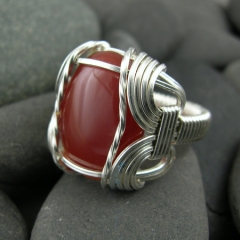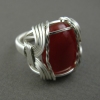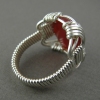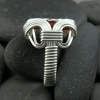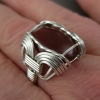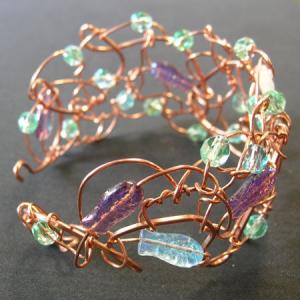Standard Form Ring (2009)
Sterling silver, carnelian
Size 10
I wasn’t intending to post this as my second entry for the YOJ, but it’s now Sunday, the due date for this week, and the piece I actually wanted to post isn’t finished. I’m “tweaking”. It feels very much like I’m doing a science experiment.
So… in the meantime…
I’m going to be teaching at Haliburton again this summer, and I have a bunch of tutorials I need to write in preparation for the class. Last fall I proposed a second level wire jewelry course, which was accepted. One of the projects is going to be the Standard Form Ring, aka Pharaoh’s Ring. (Why it’s called the “Pharaoh’s Ring” is a mystery: I haven’t been able to find any historical examples using wire. References to cast versions, yes, wire, no…). It’s called the “Standard Form Ring” because it’s one of the all-time classic wireworking ring patterns. A version of this ring was published in Moods in Wire by Ellsworth Sinclair, Beginning Wirecraft by Jessie Donnan, and in the Wire Artist Jeweller Magazine (June 2003). It’s a substantial ring, usually worn by men. I started writing my version this week, in between printing off “printing sheets” for Number 2 Son, who likes to do “homework”.
(Edit Jun. 25/09: Thanks to some excellent detective work by Helen Goga, a historical reference for the Standard Form Ring has been found! Mr. Thomas Vincent Phelan received a patent for the ring design (US Des. 150,726) in August 1948. The patent lasted for 14 years, and the design went into the public domain in 1962.)
My own personal artistic proclivities don’t lean towards classical wirework, so I haven’t made this type of ring before. I followed the WAJ instructions for my first two attempts. I often tell my students that they shouldn’t worry about what their first attempt looks like: usually with the first one, you’re just trying to get your head around the steps, so clumsiness is part of the process. It’s no different for me. This ring was attempt number 3… and I’ll likely make at least two more in the process of refining, writing and photographing the steps for the instructions.
There are useful wireworking skills to be learned from doing this project. There are definitely some “tricks” to getting it to look nice. Notes are being scribbled…
Some other views:

